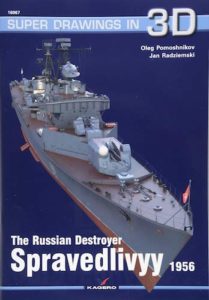 The Russian Destroyer Spravedlivyy 1956 [Super Drawings in 3D Series] by Oleg Pomoshnikov and Jan Radziemski provides a stunningly detailed look at the 1950s-era warship Spravedlivyy, later the Polish destroyer Warszawa.
The Russian Destroyer Spravedlivyy 1956 [Super Drawings in 3D Series] by Oleg Pomoshnikov and Jan Radziemski provides a stunningly detailed look at the 1950s-era warship Spravedlivyy, later the Polish destroyer Warszawa.
This series by Kagero is a treat to readers, regardless of which ship profile they purchase. Many exist, ranging from the 1940 Japanese battleship Kirishima, to the HMS Prince of Wales to the US aircraft carrier USS Lexington. These books follow a general format which is repeated in this volume, a text-based opening section which covers the history of the ship, armament and other design features along with other relevant details which help to place the vessel in context and establish the significance as well. To be treated in the 3D method means the ship has some particular redeeming features or other aspects which are revealed in very small details such as the lifeboats carried and other arcane elements which most such books cannot cover due to lack of space or need.
The authors lavish the reader with 70 pages of color images, which start with the bow and run until the ship’s stern. In between, the armament, sensors and a vast array of other accoutrements are carefully presented in a beautiful, clean manner.
For Cold War historians and modelers alike, the section that deals with the history of the Spravedlivyy, while brief, sheds important light on the ship, the times it operated in, Soviet treatment of Warsaw Pact allies and how the vessel soldiered on even as the naval technology and threats evolved. The Soviet Navy viewed itself as an important element of the Soviet military forces but never really managed parity with the United States so it was important for the 27 ships of the “Project 56” or Spokoinyy-class (NATO called them Kotlin) like Spravedlivyy to be numerous, heavily armed and capable of standing up to whatever NATO might send against it. The 130mm/58 SM-2-1 semi-automatic dual-purpose main guns could certainly pack a punch, but two five-tube 533mm MPTA-53-56M torpedo tubes are also mounted, along with four quadruple 45mm/78 SM-20 ZIF mount for anti-aircraft defense and BMB-2 depth charge throwers.
Later the Spravedlivyy gained missiles but when it was handed over the Poles in 1970 those same systems were removed, at cost to the new owners and their ability to stop NATO but in keeping with the Soviet fear of arming their surrogates too powerfully in case of a mutiny. Coalition warfare with unhappy allied forces which you plan to use as cannon fodder cannot fully comforting, so the Spravedlivyy story remains relevant as an example of the challenge of coalition warfare among less than equals with differing goals and motivations.
The images provided range from equipment to fine hull studies such as these select examples which should help to show the impressive level of detail: “Bow superstructure with FUT-B radar antenna” [10], “Port side of the midship with the bow PTA-53-56 533mm torpedo launcher battery; anti-rolling fin below the waterline” [12], “Interior of the bridge; from the left: engine room telegraph, gyro repeater, NM-1 night artillery sight” [27], “SWP-42-50 homing post with Jakor-M radar antenna” [33], “Foremast with radio-electronic instruments: at the bottom a direction-finder on an extension arm, above on a platform Neptun radar antenna, behind it Zarja radar antenna” [35], “Port side; stern of the work boat visible on the left side; cover of the bow funnel in the middle; life raft on the side” [40], “Stern view on the bow funnel and bow superstructure; boat of the ship commander visible on the right” [42], “Six oared yal and davits, port side” [51], “BMB-2 depth charge thrower and BB-1 depth charge” [62], “SM-20-ZIF gun mount with visible ammunition supply system” [69] and “Aerial view from the starboard of the work boat.” [77]
In addition to the many images, the book provides a high-quality double-sided poster with three ship views on one side and detailed line drawings on the reverse of the main guns, anti-aircraft mounts, torpedo tubes, searchlights, radar mounts and even the small boats embarked aboard.
In conclusion, The Russian Destroyer Spravedlivyy 1956 [Super Drawings in 3D Series] belongs in the possession of any Cold War enthusiast, especially a ship modeler who wants to recreate the appearance of the Spravedlivyy / Warszawa. While holding an important place in the Soviet-era Polish Navy, the Spravedlivyy also witnessed the transition period when warships traded gun mounts for missiles as the technology and threats changed. As a visual heavy work, it has application for all interest levels and would be as comfortable in a bookshelf as on a coffee table as a veritable visual feast with something for everyone.
The Russian Destroyer Spravedlivyy 1956 [Super Drawings in 3D Series #16067]
By Oleg Pomoshnikov and Jan Radziemski, Kagero Publishing, (2018).
Reviewed by Jeff Schultz. Jeff Schultz teaches history and political science courses at Luzerne County Community College in Nanticoke, PA. He has presented papers at the McMullen Naval History Symposium, the Northern Great Plains History Conference, Midwestern History Conference, Missouri Valley History Conference, The Vietnam Experience Conference, and the Seventh Triennial Vietnam Symposium about various military and naval history topics.
Click here to buy The Russian Destroyer Spravedlivyy (Super Drawings in 3D) now!

